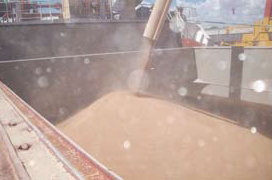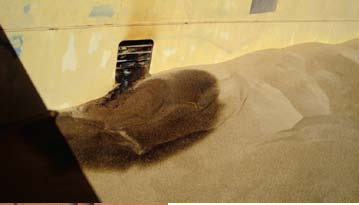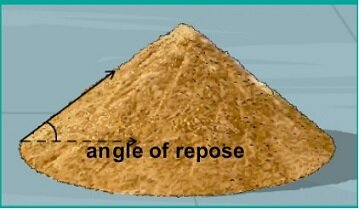
Fig: Bulk grain loading
Each ship carrying grain has to provide grain specific stability information, including grain heeling moments, to the terminal. This section looks at various problems, methods and precautions that must be taken when carrying grain cargoes. Grain cargoes carried in bags are not considered as bulk cargo.
The bulk carriers' grain loading manual contains Volumetric Heeling Moments (VHM), which are values based on an assumed surface grain shift of 15° (for a full compartment) and 25° (for a partially full compartment).
1. To avoid shifting of cargo, the grain surfaces must be reasonably trimmed:
a) Filled compartment, trimmed the cargo should be trimmed so that all spaces under deck and hatch covers are filled to the fullest extent possible.
b) Filled compartment, untrimmed the cargo should be trimmed within the hatchway but may be left at its natural angle of repose on the surrounding area of the hatchway. The same can be applied for a filled compartment, trimmed if:
- dispensation is granted from trimming by the authority issuing the Document of Authorisation on the basis that the cargo can flow freely to underdeck empty areas through feeder ducts, perforated decks, etc, or
- The compartment is designated a `Specially Suitable Compartment', in which case exemption may be granted from trimming the compartment ends.
2. If the cargo is stowed only in the lower compartment, the lower compartment hatch covers should be secured in the approved manner.
3. If the cargo is stowed in the upper compartment above a tween deck whose covers are not grain- tight, the covers should be made grain-tight using sealing tape, tarpaulins or separation cloths.
4. In partly filled compartments, the surface of bulk grain should be secured by over-stowing except in cases where heeling moments due to grain shift have been calculated and taken into consideration for stability of the vessel.
5. Longitudinal divisions may be fitted to reduce heeling moments due to shift of grain in filled compartments, trimmed, filled compartments, untrimmed and partly filled compartments, provided that each division:
a. Is made grain-tight.
b. Is constructed according to the Grain Code standards.
c. Extends from deck to deck in tweendecks.
d. Extends downwards from the underside of the hatch covers.
6. The Master shall ensure that the ship:
a. Before loading, can comply with intact stability criteria at all stages of the voyage.
b. Is upright before proceeding to sea.
c. Has all the paperwork completed and onboard.
Fumigation requirement
Charterers and shippers may require the cargo to be fumigated. If this is to be done during the voyage or before or after loading, full and clear instructions should be received from the charterers and shippers. These instructions should refer to product data sheets and the correct procedures and safety advice, application dangers, method of handling, and requirements for personal protective equipment and monitoring equipment. Refer to IMO Recommendations on the Safe Use of Pesticides on Ships. Always carry out a risk assessment.
A qualified fumigator should be engaged by the charterers when fumigation is to be done in port.
All spaces should be padlocked and sealed to prevent anyone from entering the space. No-one should enter a space that has been fumigated until after it has been thoroughly ventilated. It is recommended that an expert chemist declares whether the space is safe to enter. If the cargo requires ventilation after fumigation, advice should be sought from fumigation experts in respect to crew safety.

Fig: Fire consequence
Fuel oil tanks precautions
- masters and officers must be aware of the location of the heated fuel oil tanks
- masters and officers should monitor the tank top temperature above the fuel oil tanks as this can affect the integrity of certain cargoes particularly grain cargoes
- fuel oil temperatures can be monitored on the fuel oil transfer pumps
- masters and chief engineers should manage the fuel oil onboard to reduce heat damage to cargoes loaded in holds above heated fuel oil tanks
- heat only fuel oil tanks in use
Failed pipes onboard ship carrying grain often cause, or contribute to, many serious claims. Bagged grain on a small bulk carrier was damaged after water escaped from an air pipe running between a ballast tank and the cargo hold. The pipe had a corrosion crack where it connected to the tank top and water escaped through the crack when the ballast tank was overfilled. The ship was 20 years old, but nothing had ever been done to protect the pipe from corrosion; not even a lick of paint. Cost $220,000. Repairs to the pipe would have cost less than $150.
Measures against spontaneous combustion :
Some grade of grain cargos are carried in a damp condition and may cause spontaneous combustion to occur. The centre of these cargos will have very little ventilation to allow for cooling effect, therefore the natural heat generated can build up to such a degree that combustion takes place. Due to the restriction of oxygen, the cargo will only smolder until part of the cargo is removed, then admitting additional air will cause the cargo to burst into flames.
The only possible way to obtain an early warning of the start of spontaneous combustion is by monitoring the temperature of the cargo holds. Many ships are fitted with `temperature ports', ie pipes that are fitted beside the cargo hold access ladders into which thermometers can be lowered to obtain the hold temperature. The best practice is to leave the thermometers within the ports and withdraw them when a reading is desired. However, if the ship is not fitted with temperature ports, the sounding pipes could also be used to obtain temperatures. Whichever method is used for measuring temperature:
- The thermometers should be reset before introducing them into the pipes
- the thermometers should be left in the pipes for some time (2-3 minutes at least)
- the temperature should be measured at least 2-3 height levels within the hold
- the temperature should not be measured solely at the surface of cargo as it is likely to be quite different from that at the bottom of the cargo hold.
Modern bulk carriers may be fitted with permanent temperature sensors providing continuous readings. It is important to maintain records of all temperature observations and ensure readings are taken at the same times and at regular intervals. This makes it easy to establish a pattern for any irregularities in the observed behaviour.
Related articles on grain transport
Cargo docs:
-
Bulk carrier voyage agreement - Function of bill of lading
-
Signing a bill of lading & relevant guideline
More bulk cargo handling Information
-
Hazards of handling copper concentrate
-
Hazards of handling bulk sulphur
-
Loading, carrying and discharging of bulk coal
-
Special precaution & IMSBC code guideline for handling bulk coal
-
Risk of carrying high density iron ores in bulk
-
Salt loading guideline - Precautions & hold preparation
-
Pig iron preparations for bulk loading
-
Procedure for fishmeal loading in bulk
-
Risk of iron ore liquefaction during sea passage & countermeasures
-
Petcoke loading in bulk & associated problems for bulk carriers
-
Handling of bauxite - The environmental impact of Jamaica bauxite mining
-
Carrying gypsum -Toxins, physical reactions & environmental degradation
-
Cargo liquefaction & potential problem for transporting bulk cargo
More on grain loading
-
Hold cleaning in bulk carriers- Preparation for grain loading
-
Australian stowage requirements for vessels loading grain
-
Presence of contaminants & handling other defective grain
-
Grain terminology from IMO grain code
-
What is international grain code and why it is used in bulk carriers ?
Top articles
- Cargo information required by ship master prior handling bulk cargo
- Care of cargo during loading- Trimming pours
- Checklist for confirming stabilty and hull stress prior loading
- Cargo loading agreement between ship and terminal
- Bulk carrier loading manual
- Handling of deballasting (ship duties) during high loading rate
- Cargo and ballast handling guide
- Responsibility of ship during cargo operation
- Shipboard hazards & bulk carriers safety guideline
- Asymmetric cargo and ballast distribution for bulk carriers
- Limitations on exceeding load lines
- Risk of deviation from the loading limitations
- Cargo handling guidance for deck officers
Our detail pages illustrated many safety aspects of Bulk carrier
Home page |||Bulk carrier types ||| Handling of bulk coal |||Cargo planning ||| Carriage of grain |||Risk of iron ores |||Self unloading bulk carriers |||Care of cargo & vessel |||Cargoes that may liquefy |||Suitability of ships |||Terminal guideline |||Hold cleaning |||Cargo cranes |||Ballast handling procedure |||Bulk carrier safety |||Fire fighting systems |||Bulk carrier General arrangement
 Operation of sea going bulk carriers involved numerous hazards . Careful planning and exercising due caution for all critical shipboard matters are important . This site is a quick reference to international shipping community with guidance and information on the loading and discharging of modern bulk carriers so as to remain within the limitations as specified by the classification society.
Operation of sea going bulk carriers involved numerous hazards . Careful planning and exercising due caution for all critical shipboard matters are important . This site is a quick reference to international shipping community with guidance and information on the loading and discharging of modern bulk carriers so as to remain within the limitations as specified by the classification society.
It is vital to reduce the likelihood of over-stressing the ship's structure and also complying with all essential safety measures for a safe passage at sea. Our detail pages contain various bulk carrier related topics that might be useful for people working on board and those who working ashore in the terminal. For any remarks please Contact us
Copyright © 2010 bulkcarrierguide.com All rights reserved.
Although every effort have been taken to improve the accuracy of content provided the publisher of this website cannot gaurantee for errors. Disclaimer Privacy policy Home page


